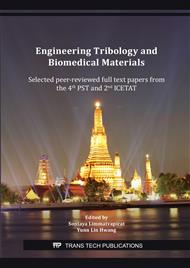[1]
R.L. Siegel, K.D. Miller, A. Jemal, Cancer statistics, 2020, CA Cancer J. Clin. 70 (2020) 7-30.
Google Scholar
[2]
Information on https://bps.moph.go.th/new_bps/sites/default/files/statistic62.pdf.
Google Scholar
[3]
N. El-Deeb, M. El-Saadani, A. El-Enbaby, E. S. Hafez, A. El Saify, Correlation between Hepatocellular Carcinoma and Hepatitis C genotypes and their role in Hepatocarcinogenesis, PAOJ. 6(4) (2013) 12-17.
Google Scholar
[4]
R. Siegel, C. DeSantis, K. Virgo, K. Stein, A. Mariotto, T. Smith, D. Cooper, T. Gansler, C. Lerro, S. Fedewa, C. Lin, C. Leach, R. Spillers, H. Cho, S. Scoppa, M. Hachey, R. Kirch, A. Jemal, E.Ward, Cancer treatment and survivorship statistics, CA Cancer J. Clin. 62(4) (2012) 220-241.
DOI: 10.3322/caac.21149
Google Scholar
[5]
J. Chavda, H. Bhatt, Systemic Review on B-RafV600E Mutation as Potential Therapeutic Target for the Treatment of Cancer, Eur. J. Med. Chem. 206 (2020) 112675.
DOI: 10.1016/j.ejmech.2020.112675
Google Scholar
[6]
L. Liu, Y. Cao, C. Chen, X. Zhang, A. McNabola, D. Wilkie, S. Wilhelm, M. Lynch, C. Carter, Sorafenib blocks the RAF/MEK/ERK pathway, inhibits tumor angiogenesis, and induces tumor cell apoptosis in hepatocellular carcinoma model PLC/PRF/5, Cancer Res. 66(24) (2006) 11851-11858.
DOI: 10.1158/0008-5472.can-06-1377
Google Scholar
[7]
Y. J. Zhu, B. Zheng, H. Y. Wang, L. Chen, New knowledge of the mechanisms of sorafenib resistance in liver cancer, Acta Pharmacol. Sin. 38(5) (2017) 614-622.
DOI: 10.1038/aps.2017.5
Google Scholar
[8]
M. Qin, S. Yan, L. Wang, H. Zhang, Y. Zhao, S. Wu, D. Wu, P. Gong, Discovery of novel diaryl urea derivatives bearing a triazole moiety as potential antitumor agents, Eur. J. Med. Chem. 115 (2016) 1-13.
DOI: 10.1016/j.ejmech.2016.02.071
Google Scholar
[9]
W. Ye, Q. Yao, S. Yu, P. Gong, M. Qin, Synthesis and antitumor activity of triazole-containing sorafenib analogs, Molecules 22(10) (2017) 1759.
DOI: 10.3390/molecules22101759
Google Scholar
[10]
Information on https://www.cancer.org/cancer/liver-cancer/treating/targeted-therapy.html.
Google Scholar
[11]
Y. Li, Z. H. Gao, X. J. Qu, The adverse effects of sorafenib in patients with advanced cancers, Basic Clin Pharmacol Toxicol 116(3) (2015) 216-221.
DOI: 10.1111/bcpt.12365
Google Scholar
[12]
C. Liu, Z. Chen, Y. Chen, J. Lu, Y. Li, S. Wang, G. Wu, F. Qian, Improving oral bioavailability of sorafenib by optimizing the spring" and "parachute, based on molecular interaction mechanisms, Mol. Pharm. 13(2) (2016) 599-608.
DOI: 10.1021/acs.molpharmaceut.5b00837
Google Scholar
[13]
K. Tang, C. Luo, Y. Li, C. Lu, W. Zhou, H. Huang, X. Chen, The study of a novel sorafenib derivative HLC-080 as an antitumor agent, PloS one. 9(7) (2014) e101889.
DOI: 10.1371/journal.pone.0101889
Google Scholar
[14]
S. Sun, Z. He, M. Huang, N. Wang, Z. He, X. Kong, J. Yao, Design and discovery of thioether and nicotinamide containing sorafenib analogues as multikinase inhibitors targeting B-Raf, B-RafV600E and VEGFR-2, Bioorg. Med. Chem. 26(9) (2018) 2381-2391.
DOI: 10.1016/j.bmc.2018.03.039
Google Scholar
[15]
A. K. El-Damasy, J. H. Lee, S. H. Seo, N. C. Cho, A. N. Pae, G. Keum, Design and synthesis of new potent anticancer benzothiazole amides and ureas featuring pyridylamide moiety and possessing dual B-RafV600E and C-Raf kinase inhibitory activities, Eur. J. Med. Chem. 115 (2016) 201-216.
DOI: 10.1016/j.ejmech.2016.02.039
Google Scholar
[16]
M. A. Zeidan, A. S. Mostafa, R. M. Gomaa, L. A. Abou-Zeid, M. El-Mesery, M. A. A. El-Sayed, K. B. Selim, Design, synthesis and docking study of novel picolinamide derivatives as anticancer agents and VEGFR-2 inhibitors, Eur. J. Med. Chem. 168 (2019) 315-329.
DOI: 10.1016/j.ejmech.2019.02.050
Google Scholar
[17]
Z. Xu, S. J. Zhao, Y. Liu, 1, 2, 3-Triazole-containing hybrids as potential anticancer agents: Current developments, action mechanisms and structure-activity relationships, Eur. J. Med. Chem. 183 (2019) 111700.
DOI: 10.1016/j.ejmech.2019.111700
Google Scholar
[18]
K. C. Hsu, Y. F. Chen, S. R. Lin, J. M. Yang, iGEMDOCK: a graphical environment of enhancing GEMDOCK using pharmacological interactions and post-screening analysis, BMC Bioinform. 12(1) (2011) S33.
DOI: 10.1186/1471-2105-12-s1-s33
Google Scholar


